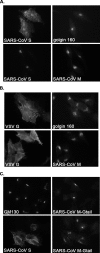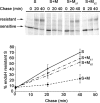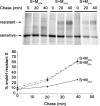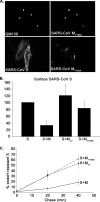A single tyrosine in the severe acute respiratory syndrome coronavirus membrane protein cytoplasmic tail is important for efficient interaction with spike protein
- PMID: 20007283
- PMCID: PMC2812384
- DOI: 10.1128/JVI.02458-09
A single tyrosine in the severe acute respiratory syndrome coronavirus membrane protein cytoplasmic tail is important for efficient interaction with spike protein
Abstract
Severe acute respiratory syndrome coronavirus (SARS-CoV) encodes 3 major envelope proteins: spike (S), membrane (M), and envelope (E). Previous work identified a dibasic endoplasmic reticulum retrieval signal in the cytoplasmic tail of SARS-CoV S that promotes efficient interaction with SARS-CoV M. The dibasic signal was shown to be important for concentrating S near the virus assembly site rather than for direct interaction with M. Here, we investigated the sequence requirements of the SARS-CoV M protein that are necessary for interaction with SARS-CoV S. The SARS-CoV M tail was shown to be necessary for S localization in the Golgi region when the proteins were exogenously coexpressed in cells. This was specific, since SARS-CoV M did not retain an unrelated glycoprotein in the Golgi. Importantly, we found that an essential tyrosine residue in the SARS-CoV M cytoplasmic tail, Y(195), was important for S-M interaction. When Y(195) was mutated to alanine, M(Y195A) no longer retained S intracellularly at the Golgi. Unlike wild-type M, M(Y195A) did not reduce the amount of SARS-CoV S carbohydrate processing or surface levels when the two proteins were coexpressed. Mutating Y(195) also disrupted SARS-CoV S-M interaction in vitro. These results suggest that Y(195) is necessary for efficient SARS-CoV S-M interaction and, thus, has a significant involvement in assembly of infectious virus.
Figures









Similar articles
-
The cytoplasmic tail of the severe acute respiratory syndrome coronavirus spike protein contains a novel endoplasmic reticulum retrieval signal that binds COPI and promotes interaction with membrane protein.J Virol. 2007 Mar;81(5):2418-28. doi: 10.1128/JVI.02146-06. Epub 2006 Dec 13. J Virol. 2007. PMID: 17166901 Free PMC article.
-
Important role for the transmembrane domain of severe acute respiratory syndrome coronavirus spike protein during entry.J Virol. 2006 Feb;80(3):1302-10. doi: 10.1128/JVI.80.3.1302-1310.2006. J Virol. 2006. PMID: 16415007 Free PMC article.
-
The SARS-CoV-2 envelope and membrane proteins modulate maturation and retention of the spike protein, allowing assembly of virus-like particles.J Biol Chem. 2021 Jan-Jun;296:100111. doi: 10.1074/jbc.RA120.016175. Epub 2020 Dec 3. J Biol Chem. 2021. PMID: 33229438 Free PMC article.
-
The SARS-CoV S glycoprotein.Cell Mol Life Sci. 2004 Oct;61(19-20):2428-30. doi: 10.1007/s00018-004-4257-y. Cell Mol Life Sci. 2004. PMID: 15526150 Free PMC article. Review.
-
The spike protein of SARS-CoV--a target for vaccine and therapeutic development.Nat Rev Microbiol. 2009 Mar;7(3):226-36. doi: 10.1038/nrmicro2090. Epub 2009 Feb 9. Nat Rev Microbiol. 2009. PMID: 19198616 Free PMC article. Review.
Cited by
-
Characterization of an Immunodominant Epitope in the Endodomain of the Coronavirus Membrane Protein.Viruses. 2016 Dec 10;8(12):327. doi: 10.3390/v8120327. Viruses. 2016. PMID: 27973413 Free PMC article.
-
Looking for a needle in a haystack: Cellular proteins that may interact with the tyrosine-based sorting signal of the TGEV S protein.Virus Res. 2015 Apr 16;202:3-11. doi: 10.1016/j.virusres.2014.11.029. Epub 2014 Dec 4. Virus Res. 2015. PMID: 25481285 Free PMC article. Review.
-
Effects of SARS-CoV-2 mutations on protein structures and intraviral protein-protein interactions.J Med Virol. 2021 Apr;93(4):2132-2140. doi: 10.1002/jmv.26597. Epub 2020 Nov 1. J Med Virol. 2021. PMID: 33090512 Free PMC article.
-
Membrane Protein of Human Coronavirus NL63 Is Responsible for Interaction with the Adhesion Receptor.J Virol. 2019 Sep 12;93(19):e00355-19. doi: 10.1128/JVI.00355-19. Print 2019 Oct 1. J Virol. 2019. PMID: 31315999 Free PMC article.
-
The nsp1, nsp13, and M proteins contribute to the hepatotropism of murine coronavirus JHM.WU.J Virol. 2015 Apr;89(7):3598-609. doi: 10.1128/JVI.03535-14. Epub 2015 Jan 14. J Virol. 2015. PMID: 25589656 Free PMC article.
References
-
- Armstrong, J., S. Patel, and P. Riddle. 1990. Lysosomal sorting mutants of coronavirus E1 protein, a Golgi membrane protein. J. Cell Sci. 95(Pt. 2):191-197. - PubMed
-
- Bonifacino, J. S., and L. M. Traub. 2003. Signals for sorting of transmembrane proteins to endosomes and lysosomes. Annu. Rev. Biochem. 72:395-447. - PubMed
Publication types
MeSH terms
Substances
Grants and funding
LinkOut - more resources
Full Text Sources
Miscellaneous

